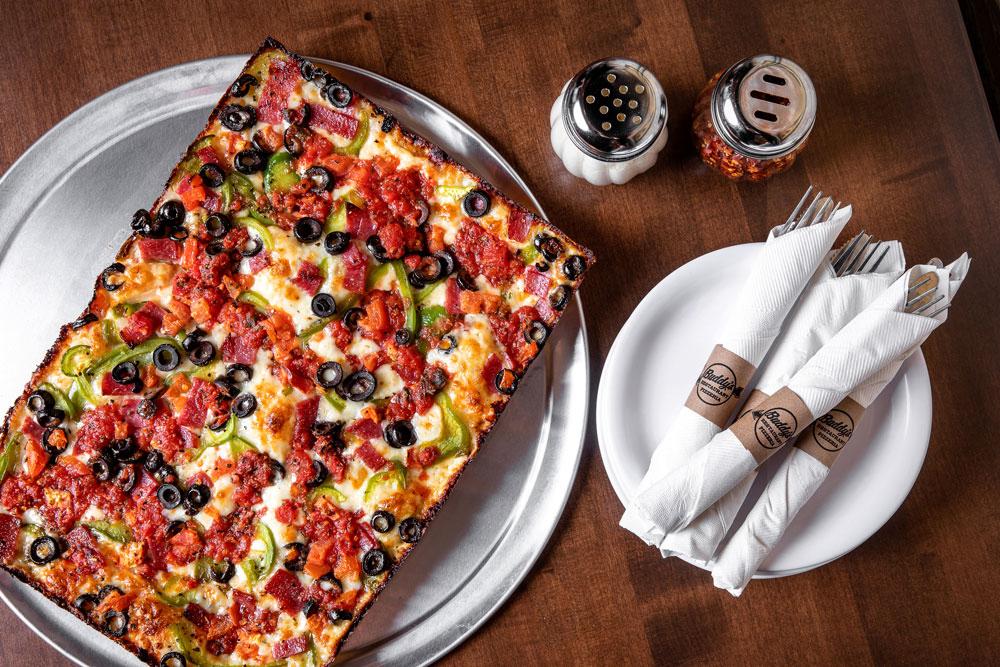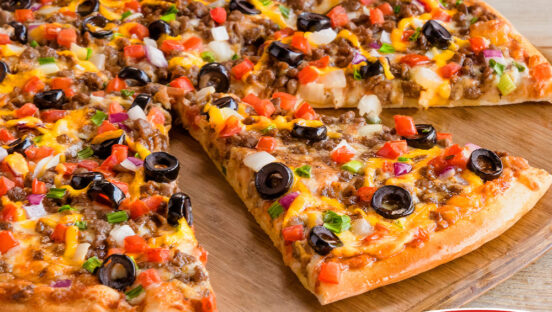By Tracy Morin
What do you get when you cross a Sicily-born waitress, a booming American automotive industry, and a now-legendary pizzeria trying to make its mark on Motor City? You might just invent a whole new style of pizza that’s going stronger in the 2020s than ever before. In other words: Detroit-style pizza.
According to legend—and, unlike with the origin of many pizza styles, this one isn’t hotly contested—Buddy’s Rendezvous Pizza was the birthplace of the pan-baked, airy, crunchy-edged slice of heaven that is known as the Detroit style. The waitress in question, named Connie, was employed by owner Gus Guerra, an Italian immigrant who’d opened his business in 1946. Many believe she helped develop the recipe, but Buddy’s old-timers admit that others, such as Guerra’s mother, grandmother or wife, also could have played a role. Whatever the exact details, the results are delicious.
Unmistakably Motor City
Detroit pies were unique from the outset. First of all, they were baked not in foodservice pans, but in rectangular blue steel pans that were used in the automotive industry (giving new meaning to the concept of eating local). “The dough is made with flour, salt, water and fresh cake yeast, then stretched to fit the shape of the pan,” explains Wes Pikula, chief brand officer at Buddy’s Pizza, still based in Detroit and opening its 23rd location. “The pepperoni is layered right on top of the dough (versus over the cheese), and we use brick cheese, not mozzarella. The sauce goes on top of the cheese using a skimming method, three spoonfuls across. The light, crunchy crust has caramelized corners because the brick cheese is spread end to end, forming a ‘bark’ on the edges with a crunchy texture. You can eat slice after slice and not feel heavy. People refer to it as the best grilled cheese they’ve ever had.”
Looking to nail your own Detroit-style pizza? Pikula breaks down the style in more detail:
- A strict dough handling procedure creates a stickier dough that’s never floured. A light coat of oil is used to stretch and press the dough into the pan, but no butter or oil is used in the recipe to condition it, creating what Pikula calls a “lean dough.” The rise during the fermentation process is designed to make a light, airy, crunchy crust that’s cut into square slices.
- Blue steel pans offer a different and faster kind of heat transfer than aluminum foodservice pans. Buddy’s seasons each new pan before using, but through repeated baking sessions, they develop a seasoning that imparts a unique flavor. Pikula notes that pans can circulate in the pizzeria for 20 or 30 years. Originally, they were only one size—10” by 14”—but now 8” by 10” is also used.
- The sauce is very mild, not overly spiced or laced with a lot of oregano or garlic. It’s also not a cooked sauce, which lets the flavor of fresh California tomatoes shine. The spooned method during the application is designed to let the stripes of sauce spread or “bleed” around the pie during baking.

Buddy’s Pizza invented the Detroit style, but the Jet’s Pizza chain has taken it further, opening more than 415 stores in 21 states since it launched 45 years ago. Photo courtesy Jet’s Pizza.
The Style Spreads
Of course, no good pizzeria legend would be complete without disagreements, breakups and bastardizations. As the Buddy’s style split off into new pizzerias, and new regions of the country and world, the style has become not only defined and admired but subject to endless iterations. “Over time, people used creative freedom,” says Pikula, who’s been around to witness the changes—he started as a dishwasher at Buddy’s nearly 50 years ago. “As people left the pizzeria and opened their own places, each left with a bit of the recipe, and things changed. We see it now in Thailand, South Korea, Mexico. Everyone’s writing about it, and everyone wants it. But when you try the knockoffs versus the original, you can taste the difference.”
Related: The story behind a famous Detroit-style mustard pie
In fact, Buddy’s is hoping more people around the country will taste the difference for themselves, as the brand has recently launched a line of frozen pizzas in major grocery stores. Equipped with their own pan to bake in, the pizzas are arriving right on time, as Detroit pizza fever has fully swept the nation in recent years. (See the sidebar for more details.)
With the style spreading worldwide, Detroit itself has started to honor its native pizza. Buddy’s founded National Detroit-Style Pizza Day in 2021 as a way for all U.S. Detroit pie slingers to celebrate on June 23. But locally, the date has been recognized as Buddy’s Pizza Day by former Detroit Mayor Dave Bing and the Detroit City Council, who credit Buddy’s Pizza for putting this now-iconic innovation on the map.
“I think what makes it great is the balance,” Pikula says. “It’s very basic, but it’s very good. You don’t need to overdo it. You can find the Detroit style in Colorado or Austin, Texas, but people who travel always say it’s so different when they come here.”
Tracy Morin is PMQ’s copy editor.
Pandemic-Appropriate Pies
Perhaps fueled by stressed Americans seeking the ultimate in comfort food, the pandemic era ushered in arguably the biggest years for the Detroit style, in 2021 and 2022. Outlets from Food & Wine to Thrillist blared headlines like “How Detroit-Style Pizza Took Over America.” Even Pizza Hut unveiled a version in early ’21.
While possibly a year or two past its peak popularity, Tastewise noted that Detroit-style pizza was still trending in 2023, with an increase of 5.51% in social discussions in the last year. Still, it has a menu penetration of only 0.56% in restaurants overall, with 4,830 restaurants currently offering Detroit-style pizza on their menu. If you’re itching to try making this iconic pie style, you’re in good company—it’s still winning competitions and intriguing pizzaioli everywhere, and there’s plenty of room in the market for more.













